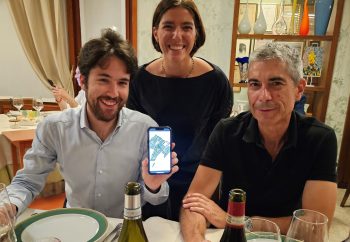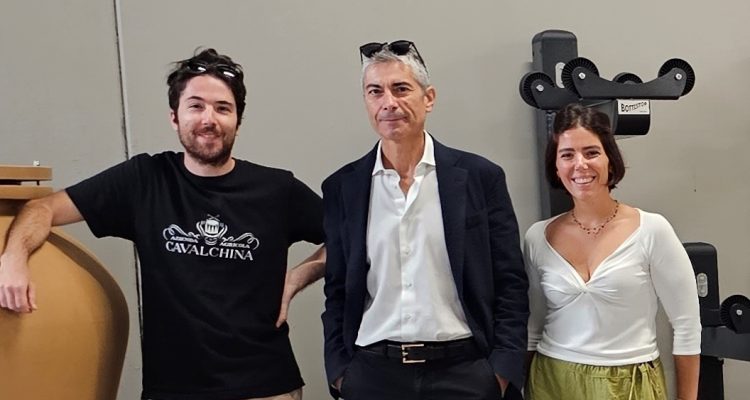On route to Cavalchina winery in Northeast Italy, the backroads suddenly looked familiar. I realized that several years ago, I passed near the small town of Sommacampagna, Cavalchina’s home base, on my way from Parma to the Lake Garda area on a cheese-focused trip. This visit I targeted the aromatic white wines from the Custoza DOC appellation near Verona in the Veneto region.
Like many who have traveled to Italy, I was not aware of the Custoza area before traveling to learn about the wines. Custoza is a place in the province of Verona, a DOC appellation, and the name of a white wine blend.
My guide to Custoza was Franco Piona, the CEO of Cavalchina winery. Franco’s grandfather Luciano was a pioneer in developing the white wines of the area, and the family has continued to lead recognition for the DOC wines. I learned about the history of the region, tasted Custoza wines, and discovered how well they pair with food in the Veneto and the U.S.
Cavalchina wine is known in the U.S. by sommeliers attuned to Italian wines. Fond of the aromatic white wines from Custoza, Nicholas Bathurst, director of food and beverage at The Plaza, Fifth Avenue at Central Park South, describes the wines to guests as “floral and fruity notes like orange blossom, elderflower, melon and banana. On the palate, a balanced minerality and clean finish.” As for pairings, he may suggest fresh Blue Point oysters, hamachi crudo or local cheeses.
“The Piona family, who started Cavalchina winery back in the early 1900s, almost single handedly put the Custoza DOC on the map. In 1962, Cavalchina was the first winery to put ‘Custoza’ on the label to differentiate it from other wines districts near Verona such as Soave. Cavalchina wines are delicious and are a true expression of the region,” said Bathurst, who has visited the winery.
The area of Custoza is located 25 miles southwest of the historic city of Verona, With Lake Garda 10 miles to the east, the cooling breezes from the late allow full ripening of the grapes, providing acidity for the white wines known for their ability to age.
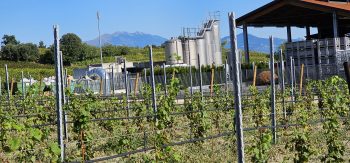
Glaciers formed the series of elongated hills of the Pre-Alps punctuated by valleys shaped like amphitheaters where vineyards and small towns such as Sommacampagna and Custoza reside. The morainic soil left by glaciers is a mix of clay, stones, sandstone, and limestone. The calcareous aspect of the soil generates the mineral characteristics of the wine and enhances their ageability.
The Romans grew olives and grapes in the region. In 1848 the ruling Hapsburg government registered the area as a grape growing district. The area received DOC status in 1971 and the Consorzio Tutela Vino Custoza DOC was established the next year to safeguard quality and market the wines.
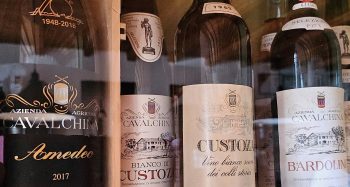
The Piona family influence on the Custoza area
Cavalchina is one of the leading Custoza producers and exporters of wine to the U.S. Franco’s grandfather Luciano bought land to plant vines in the early 1900s. Though he owned a leather processing plant, his passion was opera and wine. In 1948 he bought more vineyard land and built a winery. Along with naming the wine Custoza, Luciano distributed the wine to Rome and Milan, and developed the general recipe for the recognized Custoza blend.
The Bianco di Custoza white wines must include at least 70 percent of three local grapes, each adding unique characteristics to the wine: garganega which provides fruity and floral elements, trebbianello, related to Friulian Tocai, offers color, and bianca fernanda, a local clone of cortese which enhances the aroma. Vintners can add trebbiano toscano, riesling, malvasia, and chardonnay to the blend.
Luciano’s son Giulietto expanded the Cavalchina estate and worked to get the DOC recognized and the Consorzio established. The Consorzio identified the classifications from the basic Custoza blend to the more stringent quality requirements for Custoza Riserva and Custoza Superiore. Custoza Spumant and the sweet wine, Custoza Passito, are also part of the DOC.
During Giuliettos tenure in the 1980s and 1990s, the word spread that the white wines from the Veneto aged well. As Giulietto’s younger son Franco noted, “People realized we were on the 45th parallel which yields an ideal amount of sunlight and temperate weather to give grapes the acidity to help the wine age,”
The eldest son of Giulietto, also named Luciano, turned Cavalchina winery into the focus of the family business. A Renaissance man, Luciano was a chemical engineer as well as an avid sailor. While president of the Consorzio, he expanded recognition of Custoza wines beyond Italy. After Luciano’s passing, Franco assumed leadership of the company. Luciano’s children, Guilia and Francesco are also senior members of the Cavalchina team and eager to talk about their vineyards and wine.
Franco has brought a unique blend of talents to the winery. Inheriting his grandfather’s love of music, the vintner is also a guitar player and drummer—and a degreed electronics engineer. His father encouraged him to study the science of his choice. After university, Franco joined the family winery and trained with famed enologist Roberto Ferrarini from the University of Verona. Franco’s enthusiasm for Custoza wines is contagious.
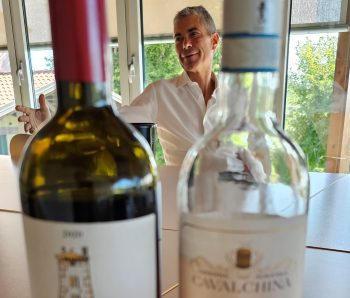
Cavalchina wines
During my visit to Cavalchina, I visited the cellar with the Pionas. The family owns four vineyard estates in the region, all sustainably managed. Along with the Custoza grapes, chardonnay and other international varieties vines are grown and vinified.
The grapes for the Custoza blends are fermented separately, and each vineyard is cellared in a separate tank until blending. Bucking Veronese tradition, the winery uses smaller, French barriques in addition to the large, Italian botti barrels. New amphorae are used for aging wines. The winery features a Bottistop barrel stacking and rotating system which also allows more efficient cleaning and filling of barrels.
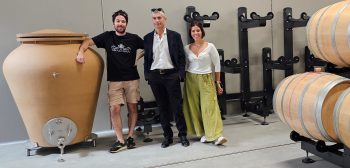
We walked in the vineyard surrounding the historic property. The land was once owned by Conte Cavalchina after whom the village is named. The vineyards are sustainably managed by consulting viticulturists
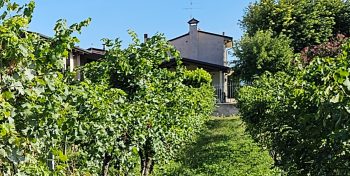
Later we tasted through the Cavalchina portfolio. After sampling Bianco di Custoza. the largest export to the U.S., I enjoyed the aromatic nose, medium body, and smooth texture. I also tasted another Cavalchina top seller in the U.S., the Bardolino Chiaretto, a refreshing rosato in the Provençal style from the red grapes of the Bardolino DOC which overlaps the Custoza DOC.
The most memorable wine that I tasted with the Piona family was the Amedeo Custoza Superiore. The 2014 Amedeo still tasted fresh; the 2021 vintage was dry, fruity and lively. When I used the French word vivacité to indicate the wine’s lively taste, Franco shared the Italian word vivace.
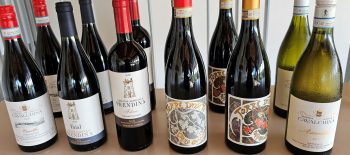
Dining with wines of the region
Traditions run deep in the Custoza area. As a child, Franco learned the Veronese dialect, a blend of Austrian German, French and Italian which is now losing users. On the first evening of my visit, Franco arranged dinner at the well-known, historic Ristorante Alla Borsa in Valeggio sul Mincio. A highlight of the Veronese food culture is tortellino, a small version of tortellini. The pasta is cut, stuffed with delicate fillings, and then tied into a knot. The tortellino are called “love knots” based in a local legend and served and popularized by Alla Borsa since 1959.
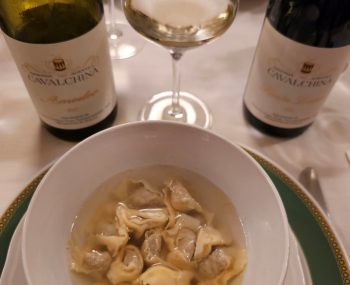
As the multi-generational family owners of the restaurant graciously served three savory courses of tortellino, they shared stories about their special pasta and personal knowledge of Custoza wines.
The first tortellino arrived in broth and stuffed with a mixture of meat and vegetables. Franco poured the Amedeo Custoza Superiore which paired beautifully with the elegant pasta and light soup. The Amedeo also paired with the next course of tortellino with a light filling of ricotta and spinach. To finish, the tortellino arrived with a meat ragu, a Bolognese specialty which was sautéed with local Bardolino red wine.
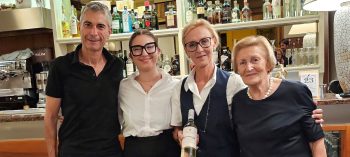
Before leaving the area, I enjoyed lunch with the Pionas at Antica Bottega del Vino in Verona. Located near the Roman amphitheater, the restaurant is packed with vinous history. The wine list nearly swamped me.
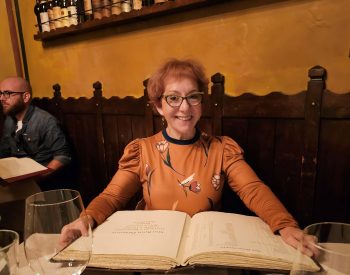
I swapped out Custoza white wines for Calvachina’s Valpolicella under their Torre d’Orti label to pair with the sweet and sour gallina (young chicken) with capers and pine nuts and then a delicious risotto with Amarone.
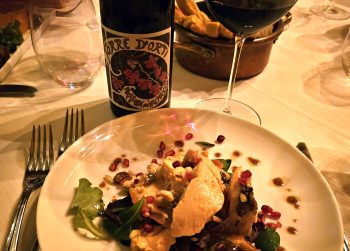
Reluctantly I left the Veneto region and returned to the San Francisco area where I enjoyed dinner at One Market restaurant. Award winning sommelier Tonya Pitts noted that her goal is to take the wine drinker on a journey in the glass.
“I share the undiscovered white wines from the Custoza area as a good alternative to white Rhone varietals, riesling and grüner veltliner,” said Pitts.
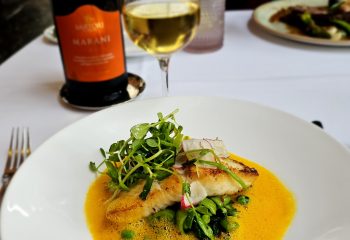
Though Pitts does not currently list Cavalchina, she suggested the garganega from Casa Sartori to pair with Executive Chef-Partner Mark Dommen’s seasonal fresh halibut, octopus, grilled Idaho trout or poultry.
At Alla Borsa restaurant before the tortellino arrived, the Cavalchina team was eager to show me their vineyards and share that they have room to expand the estates. The future looks bright for Cavalchina, the Custoza area and white wines from the Veneto.
